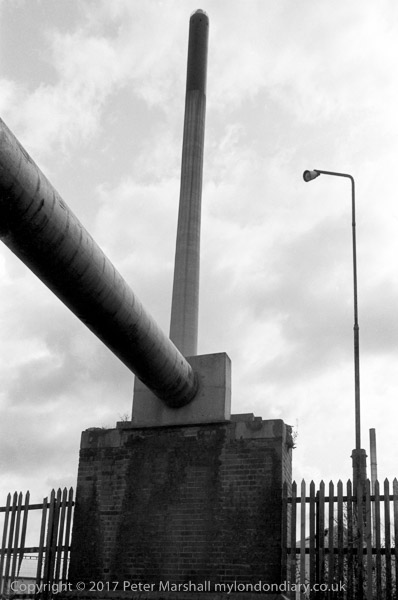
32r25: Pipe bridge, Bankside and Reckitt's
Chimney, Morland St, 1982 - River Hull
Previous
Next
A view of Hull
Still Occupied
Images on this site are arranged into rough areas by location as in my book 'Still Occupied', available on Blurb. Eventually this site will contain all the images in that book and more.
The River Hull is out of sight between these two large objects that it amused me to join together in the picture. Reckitts had originally relied on imported ultramarine to use in their 'Reckitt's Blue' washing additive, but began to make their own when it became difficult to get supplies because of the Austro-Prussian wars in the 1860s. In 1884 they built a large factory to make it in Morley St, making use of water from the RIver Hull and discharging some fairly noxious effluent back in exchange.
But the major pollutant was sulphur dioxide which was simply dispersed into the atmosphere through a chimney, perhaps the shorter one towards the right of the picture, making rain in Hull highly acidic. In the 1970s the company had a taller chimney built, at 141m Hull's highest building by quite a margin, so that the pollution could then be carried across the North sea to kill the forests of North Germany. At the time it was the tallest structure in the world to be built by the continuous pouring of concrete, and high winds during the construction caused a few slight kinks (some say that a short strike by workers on the project also had the same effect.)
Shamefully it was only early in this century that the owners of the plant - by then Holliday Pigments - installed flue-gas desulphurisation plant. Having done so they then closed down the plant in 2007, transferring production to their more modern plant in France. Although no longer used for whitening whites in washing machines - Reckitt's Blue went out in the 1950s, replaced by organic optical brighteners - ultramarine is still in demand for other purposes.
There is still a pipe bridge across Bankside, just to the north of the railway bridge, but it has a smaller diameter and the pipe curves down at the end. This was also present when I took this picture a little further to the north. There is now a gantry across the street in a similar position to protect the pipe against collisions with tall vehicles, and presumably the pipe is at the same or higher level than the Hull rail bridge, which protects it from traffic from the south. It is possible that this large pipe was a similar protection rather than an actual pipeline across the road.
Peter Marshall
01784 456474